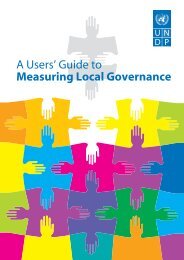English - UNDP
English - UNDP
English - UNDP
You also want an ePaper? Increase the reach of your titles
YUMPU automatically turns print PDFs into web optimized ePapers that Google loves.
Local Governance and Decentralization<br />
Implementation of the District Development<br />
Plans requires financial resources from<br />
national budgets<br />
The methodology introduced for district development planning<br />
promoted a new development paradigm in Tajikistan. But the<br />
implementation of district development plans remains a much<br />
more challenging task, mainly due to limited financial resources.<br />
Financing district development plans is restricted mainly to<br />
mobilizing extra-budgetary funds (local and international) with<br />
no link to the national or regional budgets. Implementation<br />
is also hindered by cumbersome financial and reporting<br />
procedures imposed by international development partners.<br />
The Tajikistan experience shows that participatory planning<br />
could be successful during the planning phase. But to ensure<br />
that priorities are acted upon, planning processes must be<br />
linked to the national budgeting and expenditure frameworks.<br />
For better utilization of funds from international funding<br />
opportunities, there is a need to develop commonly adopted<br />
procedures in parallel with planning.<br />
The sustainability of a participatory planning<br />
concept at the district level has to be ensured<br />
District development councils supported through the DGTTF<br />
projects served as a coordination mechanism for different<br />
activities within the district development framework. By bringing<br />
together local stakeholders, including government, civil society,<br />
and the private sector around common development priorities,<br />
the councils have served as a platform for building confidence<br />
and trust among them and for participatory decision and policy<br />
making.<br />
The establishment and functioning of the district development<br />
councils is inherently linked to sustainability. The district<br />
development councils were an effective interim solution in<br />
the aftermath of the civil war and during the transition period<br />
for the establishment of the national (governance) institutions.<br />
However, there is a need to transform district development<br />
councils into a more meaningful and sustainable form of<br />
(district) development planning. The DGTTF support provided<br />
a solid basis for sustainability, especially by addressing gaps in<br />
technical expertise. Therefore, it will be essential to start with<br />
the transformation of district development councils, taking into<br />
consideration activities and results of the DGTTF supported<br />
projects in Tajikistan.<br />
DGTTF – need for comprehensive<br />
knowledge management<br />
DGTTF projects in Tajikistan produced valuable tools and<br />
knowledge products, such as citizens’ report cards, citizen<br />
charters, a methodology for planning, budgeting, and monitoring<br />
and evaluation at district level, a methodology for regional<br />
development planning, and a number of practical documents<br />
and learning materials to support transparent and accountable<br />
governance. However, this knowledge is not collected and<br />
captured systematically. Some of these documents are either<br />
stored in the project archives or are unavailable because of<br />
changes in the project management, or because of closure of<br />
project tools and products.<br />
Opportunities to establish a comprehensive and user-friendly<br />
knowledge management system to codify and store generated<br />
knowledge should be explored. This will facilitate the horizontal<br />
learning process and ensure better exchange of information<br />
and access to knowledge derived from different DGTTF projects.<br />
DGTTF should improve monitoring practice<br />
The review of the DGTTF projects in Tajikistan showed that<br />
monitoring (and, to a large degree, reporting practice) was<br />
critical in the management of projects. Projects were approved<br />
and implemented without a clear and measurable set of<br />
indicators at different levels of intervention logic (outcome,<br />
objective, results). Monitoring visits were not organized during<br />
implementation. This review was the first on-site visit to DGTTF<br />
projects in Tajikistan and it occurred long after completion of<br />
projects.<br />
Changes to the DGTTF implementation framework (extended<br />
duration of projects and increased budgets) would require a<br />
robust monitoring system. Considering that the project duration<br />
is two years, it is recommended that mid-term reviews are<br />
conducted after the first year of project implementation. This<br />
could identify deficiencies in the project implementation and<br />
provide recommendations for the remainder of the project<br />
period. Therefore, it will be essential to concretely define the<br />
results (outputs) at the formulation phase so that they are<br />
expressed in a manner that enables effective monitoring and<br />
subsequent evaluation 31 .<br />
31<br />
In other words, the results should be S.M.A.R.T. (Specific, Measurable, Attainable,<br />
Realistic, and Time-bound)<br />
24








![GuÃa del Usuario ] - Governance Assessment Portal](https://img.yumpu.com/44740603/1/190x253/gua-a-del-usuario-governance-assessment-portal.jpg?quality=85)








